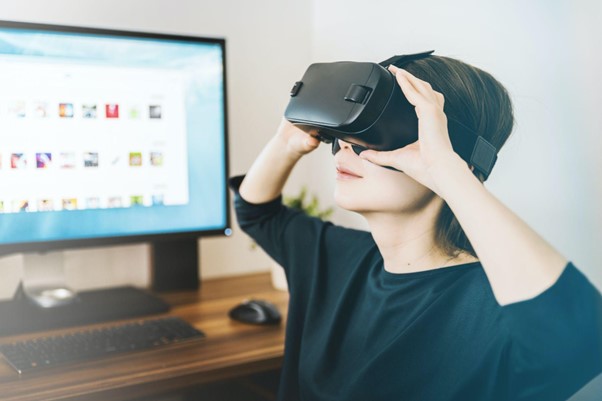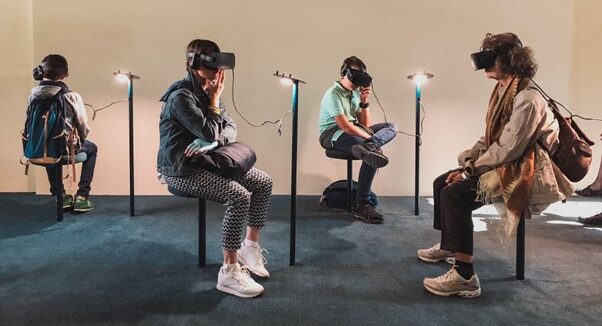Advantages of Virtual Reality in Education
Virtual Reality (VR) has rapidly emerged as a powerful tool that has captured students’, teachers, and education experts’ attention. Known for its ability to create an immersive learning experience, VR technology is transforming education with its endless potential to revolutionize the way students learn. It has made learning more interactive, natural, and engaging, creating a new dimension for educational institutions. Its vast range of benefits has made it a preferred method for education delivery. With the advent of VR, students can explore the world beyond their textbooks and classrooms and become active participants in their learning process.
ENHANCED LEARNING EXPERIENCE
Immersive Learning
It refers to the use of VR-oriented content to create a more engaging and interactive learning experience for students. This method of learning creates an environment that is fully interactive, lifelike and replicates real-life situations. The carefully designed Virtual Reality (VR) allows students to experience, observe, and practice their knowledge in a safe environment. Immersion in Virtual Reality allows students to better understand complex subjects such as science, engineering, and medical procedures. It enables them to comprehend difficult topics more quickly and efficiently than traditional classroom methods. VR also allows teachers to present material in ways that are beyond the reach of traditional classroom instruction, both for the presentation of abstract concepts and potentially dangerous situations.
Moreover, in Immersive Learning, students have the opportunity to experience realistic simulations of historical and cultural events, allowing them to observe and understand different cultures, places, and times, using their perspective. They can explore virtual locations such as museums, art galleries, and even other planets in the comfort of their classroom or homes.
They can simulate traveling to different countries and learn about their culture, language, and traditions. Lastly, Immersive Learning helps improve students’ retention and recall abilities. Students can retrieve information more efficiently from VR learning as the experience is stored in long-term memory. This method prompts them to become more engaged and motivated, resulting in better learning outcomes compared to the traditional classroom model. Overall, Immersive Learning has tremendous potential in transforming education and providing a more engaging and interactive learning experience.
Active Learning
Active learning is another crucial subtopic when discussing the advantages of Virtual Reality in education. It refers to the approach where students take an active role in their learning process by collaborating with classmates, and teachers, and interacting with the content actively. With the help of Virtual Reality, students can experience active learning in a way that traditional classrooms can never provide. Virtual Reality enables a fully interactive environment where students can engage with the content, ask questions and receive immediate feedback.
VR can simulate any environment, whether it’s a lab, museum, historical event, or simulated workplace, which gives students practical hands-on experience. Active learning in Virtual Reality allows students to acquire skills by doing rather than just listening. The interactive environment created by VR motivates students to explore and interact with the content actively.
It enhances their analytical skills and promotes critical thinking and decision-making abilities. Since they can access the information they need directly from the virtual content, students are not limited to asking their classmates or consulting textbooks. Additionally, active learning in Virtual Reality supports collaborative learning as students can participate in team-based activities, simulations, and group projects.
Via VR, students can share a virtual environment, discuss concepts, and create solutions as a team. This fosters social interaction, improves communication skills, and ultimately enhances the learning experience. Moreover, Virtual Reality helps overcome language barriers as users can select their preferred language. Thus, individuals from different parts of the world can learn and collaborate without the language barrier as it translates the language in real time.
IMPROVED RETENTION
Better Engagement and Attention
Virtual reality can significantly improve student engagement and attention when used as an educational tool. It offers a range of experiences that are not possible in traditional classroom settings. By engaging students in digital environments, virtual reality can create an immersive and dynamic learning experience. One of the benefits of virtual reality education is that it can help students connect with the subject matter in a more profound and meaningful way.
When students are engaged and interested in what they are learning, they are more likely to retain information. By using virtual reality in education, teachers can create opportunities for students to explore and learn in fun and educational ways. Virtual reality can simulate complex, real-world scenarios that would otherwise be difficult to recreate or experience in the classroom. Students can be travel to different parts of the world, traverse through time, or explore things that are inaccessible. In addition to engagement, virtual reality can increase the attention levels of students.
It promotes active learning by requiring learners to be fully present and engaged with the environment. Students can be presented with challenges or puzzles that require them to think critically to solve problems, enhancing their cognitive abilities and increasing their attention span. By creating a more interactive and immersive experience, virtual reality education can provide a hands-on approach that engages students encourages creativity, and improves information retention. As technology continues to develop and become more accessible, it is likely to play an increasingly important role in the education system, creating new ways for students to learn and explore.
Memory Retention Enhancement
Virtual reality technology can significantly improve memory retention in students. By immersing learners in a digital environment, VR creates an unforgettable and engaging learning experience that students are more likely to remember over time. Virtual reality education provides an immersive, interactive, and multi-sensory experience that closely resembles real-life situations. This provides students with an experience different from just receiving information passively.
The use of VR technology stimulates both the visual and auditory senses of the learners, making the experience more memorable than the traditional modes of teaching. The immersive nature of VR in education creates situations that trigger emotions and attitudes essential to memory formation. When learners take on a role in an educational VR experience, they become more invested and engaged in the learning process.
This incites the brain to store new information in a way that is more accessible for future recall. Moreover, VR in education can provide challenging situations that increase mental acuity, which leads to a greater level of cognitive processing. This greater level of processing strengthens the connections between the brain’s neurons, developing long term-memory.
Gamification of Learning
Gamification of Learning is one of the many advantages of Virtual Reality in education. It is a teaching method that employs game design elements in a classroom scenario to increase student engagement and participation in the learning process. Gamification of Learning is used to increase the motivation level of students to learn by using game mechanisms like points, badges, and leaderboards. In this method, the learning process becomes fun and interactive, where learners engage in challenges, quests, and quests to complete learning objectives.
Virtual Reality’s immersive nature is well-suited for the gamification of learning, allowing learners to engage in a quest and immersive storyline to achieve their learning goals. The VR technology captures students’ attention and helps them to maintain a high level of engagement throughout the learning process.
COST-EFFECTIVE EDUCATION
The use of virtual reality tools can reduce education costs in many ways. Firstly, it reduces the cost of travel and accommodation for students and teachers. With virtual reality, students can experience field trips in different locations and even explore underwater or space without the need to go anywhere physically. Moreover, virtual reality can also reduce the cost of hiring subject experts. Virtual reality technology allows subject experts to record lectures and presentations.
The virtual reality tools replicate these lectures with the same level of engagement for the students, making it easier for several students to learn from the same material. By using virtual reality tools, education providers can benefit from the best teachers worldwide without compromising the quality of education. Lastly, virtual reality technology can eliminate the need to purchase expensive laboratory equipment.
With virtual simulations, students can perform every experimental task in the safety of the classroom, reducing the cost of laboratory equipment and operating costs. This makes upskilling, or getting certified in a particular skill-set far cheaper and accessible for anyone, regardless of their geographic distance and economic background. In conclusion, Virtual Reality technology provides a cost-effective solution to traditional education systems.
Education providers can utilize virtual reality tools to save money on travel, hiring subject experts, and purchasing expensive laboratory equipment. With the implementation of virtual reality technology, education becomes more accessible, effective, and engaging for students, without a substantial increase in costs.
CONCLUSION
In conclusion, virtual reality brings a whole new level of immersion and interactivity to the classroom, providing numerous advantages for both students and teachers. VR allows learners to experience realistic simulations and environments that would be otherwise difficult or impossible to access, enhancing their engagement and retention of knowledge. With VR, teachers can create more interactive and dynamic lessons that cater to different learning styles, fostering a more personalized and inclusive educational experience.
Moreover, virtual reality is a cost-effective and scalable solution, allowing educational institutions to save resources while reaching a wider audience. As technology advances, the potential of VR in education will grow, opening up new opportunities for innovation and creativity. Therefore, incorporating virtual reality into the educational curriculum can help elevate the learning experience and equip students with the skills and knowledge needed to succeed in our rapidly evolving world.


















